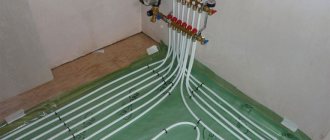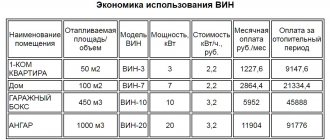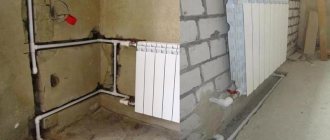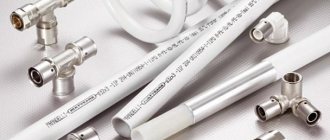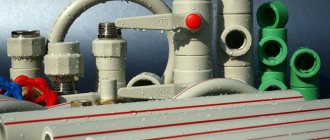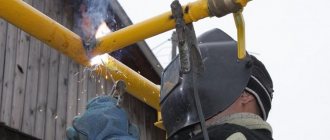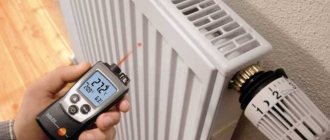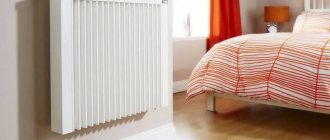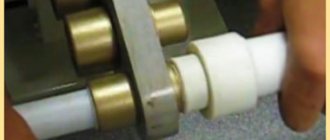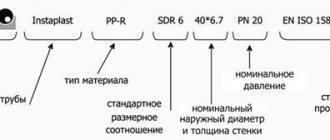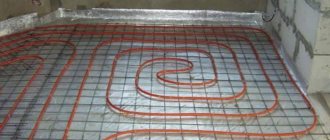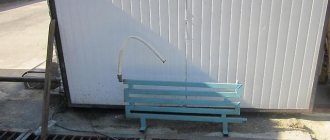Pipe features
The metal-plastic pipe consists of three layers. The outer one is made of protective polyethylene, the inner one is made of cross-linked polyethylene. And between them there is an aluminum layer. The layers are glued together with a special compound that secures them securely.
The inner layer easily withstands temperature changes and exposure to chemicals. It is antistatic, and the smooth surface does not interfere with the movement of liquid. Cross-linked polyethylene has molecular memory. This means that over time the material restores its original shape. This is a very important feature, since the pipe does not deform due to loads. There is no plastic slipping or clogging on corners.
The thickness of the aluminum foil layer is usually from 0.2 mm to 1 mm. The optimal value is 0.5 mm. This design minimizes expansion of the plastic due to heating.
Helpful information! Polyethylene and aluminum have different rates of thermal expansion. In low-quality pipes, temperature changes can cause layers to separate. Therefore, it is recommended to buy products from reputable manufacturers.
Metal-plastic
Pipe products made of metal-plastic are multilayer reinforced structures, the frame of which is an aluminum pipe with a thickness of 0.2 to 2 mm. Outside and inside, the product has a shell made of PE-X polymer. The plastic layers are connected to the aluminum with an adhesive.
Due to the smoothness of the plastic surface, they do not clog as much as steel and cast iron ones. The aluminum layer prevents the penetration of oxygen into the pipes, increasing their service life, and significantly reduces the thermal expansion of the plastic.
The operating temperature of metal-plastic products is +95C, the maximum is +130C. The pressure they can withstand at 95°C is 10 atmospheres, at 25°C – 25 atmospheres.
Metal-plastic pipes can be installed and replaced quite easily yourself. They are connected by compression fittings-adapters with threads. However, the reliability of such connections may be insufficient, especially if used unprofessionally. It is better to invite a master for these purposes. Press fitting is considered a much more reliable method, but it requires a special tool - press pliers.
USEFUL INFORMATION: How to choose and install a socket for an electric stove?
Differences between metal-plastic pipes
Advantages of metal-plastic pipes:
- The maximum temperature of the transported liquid is 110 oC;
- Maximum pressure - 25 atmospheres at a liquid temperature of up to 25 oC, 10 atmospheres at a liquid temperature of 95 oC;
- If you follow all recommendations for installation and operation, a metal-plastic pipeline for cold water will last from 50 years, for hot water - up to 50 years;
- The inner coating of the pipe is very smooth, nothing interferes with the transportation of liquid, and no blockages occur;
- High thermal conductivity, pipes are excellent for heating systems;
- The material is flexible; the product can be given the desired shape without the use of special tools;
- The length of the bay is from 50 to 200 m, fewer joints will be required;
- Easy to install, no welding required.
But they also have several disadvantages:
- Metal-plastic pipes, as well as materials for their fastening, are more expensive than plastic ones;
- Pipe diameter from 16 to 63 mm;
- It is not recommended to place metal-plastic pipes in walls, since the joints weaken over time;
- Icy water can lead to rupture of a metal-plastic heating pipe;
- Pipes are not resistant to thermal radiation, ultraviolet radiation, and mechanical damage;
- Metal-plastic pipes are not suitable for laying water fire extinguishing systems.
Characteristics of metal-plastic pipes
There are several classifications of metal-plastic pipes. According to one of them, water supply pipes are divided into types according to the method of welding the aluminum core (overlapping or butt welding). According to another classification, pipes are distinguished by the plastic used on the inner and outer shell:
- heat-resistant polyethylene (PE-RT); — polyethylene (PE-R); — high-strength cross-linked polyethylene (PE-X); — polypropylene (PP-R).
Cross-linking of PE-X pipelines can be performed using the following technologies:
- using a flow of directed electrons; - pyroxide; - using azo compounds of molecules. The crosslinking technology used is indicated on the pipeline marking.
For the production of metal-plastic, highly elastic aluminum with a thickness of 0.2-0.3 mm is used, manufactured using a special technique. Therefore, the pipes retain their shape and have good flexibility throughout their entire operation. Polyethylene protects aluminum from external factors. The performance indicators are influenced by the quality of the glue that is used when gluing the layers of pipes. Its significant adhesion to aluminum and polyethylene produces high-strength joints that are resistant to high temperatures and elastic.
Metal-plastic pipes have the following characteristics:
— maximum operating temperature 95ºC; — maximum operating pressure from 10 to 25 bar; — temporarily permissible temperature up to 130ºC.
Under such conditions of use, metal-plastic will last 50 years. The diameter of the pipes can be 16-63 mm. The scope of use of metal-plastic is wide:
— cold and hot water supply systems; - heating systems; — installation of “warm floor”; — transportation of compressed air and chemical liquids, etc.
Are polypropylene pipes better?
The area of application of polypropylene pipes coincides with metal-plastic pipes; they are competitors. The characteristics of the products are identical in most respects, since most of them are plastic. But their performance characteristics still differ. And many people do not understand what is better: metal-plastic or polypropylene pipes.
The second type of product is used in plumbing, heating, ventilation systems, and so on. There are different types of polypropylene pipes. For the installation of heating systems, polypropylene is used, reinforced with aluminum foil with holes or fiberglass. Such reinforcement reduces thermal deformation by an order of magnitude.
Distinctive features of polypropylene pipes:
- Resistance to mechanical stress, increased strength;
- The reinforcing layer is sealed into the walls of the product, so delamination is impossible, temperature changes do not affect the integrity;
- Icy water cannot rupture or in any way deform the water supply system, and the same applies to hot water. After exposure, the pipe takes its original shape;
- Possibility of transporting substances with chemical additives without harm to pipes.
Recently, antioxidants have been added to polypropylene pipes, making them resistant to oxidation by chlorine. Therefore they are suitable for transporting drinking water.
Technical characteristics of polypropylene pipes:
- Maximum temperature - 95 oC;
- Maximum pressure 25 atmospheres at temperatures up to 25 oC, 7 atmospheres at temperatures 95 oC;
- The service life of the pipe when transporting hot water is 25 years, cold water - over 50 years;
- Installation of a polypropylene pipeline is much cheaper due to the low cost of components;
- Reinforced water supply can be installed under tiles.
Flaws:
- If you plan to transport high-temperature liquid at high pressure, then the service life of the pipes will be no more than 3 years;
- No UV resistance;
- Not suitable for placement in facilities with a high fire hazard;
- More complex installation, since the pipes do not bend.
- Hot mounting requires experience and special tools.
- The pipes are not suitable for use in regions with significant negative temperatures.
An important difference between metal-plastic pipes and polypropylene pipes, which must be taken into account when choosing, is the installation method. It varies greatly for each type of product.
Advantages of polypropylene
- tightness of connections - thanks to this, such pipes can be used in hidden heating and water supply systems, embedded in the floor or walls, without fear that they will leak;
- non-corrosion and long service life - 50 years;
- high mechanical strength;
- constant internal diameter throughout the entire service life - the smoothness of the internal walls prevents the appearance of scale and various deposits;
- good sound insulation - you can’t hear the sound of water in the pipes;
- fairly simple and quick installation - the process of welding joints takes minimal time;
- absence of interaction of the material with chemically active substances - does not affect the composition of water, without changing its taste, smell and color;
- environmental friendliness - polypropylene is absolutely harmless to humans, and its processing does not harm the environment;
- high plasticity and expansion ability - pipes withstand freezing and after thawing return to their original shape and size without deforming or bursting;
- relatively low cost.
USEFUL INFORMATION: Why does hot water flow from a cold tap?
Installation of metal-plastic pipeline
In a metal-plastic pipeline, the weakest link is the joints. It is almost impossible to achieve complete tightness on them. Therefore, it is necessary to select high-quality materials and perform installation as accurately as possible. There can be no talk about the longevity of joints in an apartment building, since fluctuations in pressure and temperature can lead to the collapse of layers with leakage. But in a private house everything is different. These indicators are much more stable, so the service life of the products corresponds to the declared one.
Metal-plastic pipes are quite easy to install. You can easily do it yourself; all you need is a wrench. First, the pipeline is laid out. And then they move on to joining the pipes (about
Installation of polypropylene pipes
The main advantage of polypropylene products is monolithic joining. The layers of the pipe are soldered together at high temperature using a special soldering iron. Therefore, individual elements become a single whole. Leakage is impossible in polypropylene pipes; they are often mounted in walls. But they are not suitable for use in rooms with temperatures of 0 oC and below.
Connecting polypropylene pipes is a much more complex process. It is performed using soldering. In this case, preliminary preparation is necessary (the pipe cut is cleaned, dirt is removed from the surface). The pipes themselves are not deformed, so water pipe bends are made by soldering additional elements. Although the materials themselves are cheaper, installation in the case of polypropylene pipes will be more expensive when compared with metal-plastic products.
As in the previous case, installation must fully comply with the technology. Only a person with experience in this matter can perform the task correctly. An amateur cannot cope with high-quality installation of polypropylene water supply.
Polypropylene pipes with reinforcement are intended for heating and hot water supply systems, because a simple analogue is deformed when exposed to high temperatures. Fastening of products is carried out using the sliding method. The riser is secured with hinges during installation.
Repair of metal-plastic pipes
The beginning of any pipe repair is identifying the leak area, shutting off the water supply, and drying.
The pipe is also cleaned of dust and grease in advance. The most well-known type of repair is a bandage, but this is a temporary method. A triangle is cut out of rubber, applied to the leakage area and secured with clamps or wire. Another temporary method is to install a flange and seal it with sealant. The leak area can be covered with epoxy glue, wrapped with a bandage and another layer applied. To reliably repair a damaged pipe, you need to measure the required length and purchase a connecting fitting. Then the leak area is cut off and a section is inserted, which is connected to the main pipe with a fitting.
Criterias of choice
You will be able to correctly understand whether metal-plastic or polypropylene pipes for water supply are more suitable if you take into account the following nuances:
- What is the purpose of using pipes ? If you plan to transport cold water, then polypropylene is preferable; there will be no leaks in it. Metal-plastic products with press fittings will be optimal for implementing a heated floor system. An experienced specialist will be able to suggest the best option for supplying hot water or installing a heating system (pro
